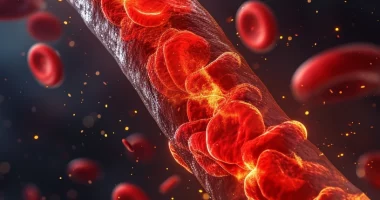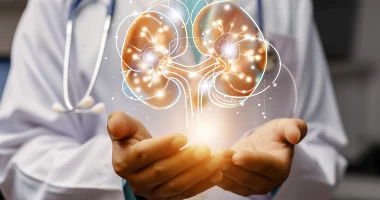Diverticular disease
What’s that?
Diverticular disease is characterized by the formation of two or more pouch-like bulges – diverticula – in the wall of the large intestine. It is manifested by constipation and nonspecific pain syndrome in the abdomen, sometimes accompanied by inflammation in the wall of the the adjacent colon, bleeding, and other complications. Reducing the risk of adverse consequences of intestinal diverticulosis will help the doctor clarify the diagnosis and recommendations for treatment at the appearance of the first signs of this disease.
About the disease
Diverticular disease is a chronic pathology that can exist for years asymptomatic and without progression. It is diagnosed predominantly in patients over 80 (at this age, intestinal bulges are found in 2/3 of the population). However, this does not mean that intestinal diverticula do not form at a younger age – they can become a diagnostic finding in a thirty-year-old patient, but they are usually asymptomatic and remain undiagnosed.
Pathologic bulges are usually formed in the lower part of the descending and sigmoid colon, while they practically do not occur in the rectum. Their average size ranges from 3 mm to 1 cm, but diverticula can be 4-5 cm in diameter, sometimes larger.
Types
According to the peculiarities of the clinical course, three types of intestinal diverticulosis are distinguished:
- asymptomatic (there are bulges in the wall of the intestine, but there are no clinical signs of pathology);
- clinically apparent (characterized by the presence of manifestations of the disease without signs of inflammation, bleeding, or other complications);
- diverticulitis (an inflammatory process in the wall of the diverticulum with a characteristic clinical picture).
There is also a division of diverticula into true and false diverticula. The wall of a true diverticulum is represented by all three layers of the intestine, including the muscular layer. False diverticula do not have a muscular layer, as they are bulges of the outer and inner walls of the colon between its muscle fibers. True diverticula include Meckel’s diverticulum, a congenital sac-like protrusion of the ileum. When we speak of intestinal diverticulosis, we mean false or pseudodiverticula.
Symptoms
Four out of five patients with this disease do not present any complaints – they are asymptomatic. As the bulge fills with hardened fecal masses and stretches, patients experience abdominal pain – constant or periodic, non-intense, aching, pulling, which is accompanied by a violation of the act of defecation – constipation, bloating of the intestines.
Inflamed intestinal diverticula show these symptoms:
- intense pain in the left iliac region;
- an increase in body temperature to subfebrile (37.0-37.9°C) or febrile (38-39°C) values;
- a persistent stool disorder– constipation.
With atypical localization of bulges, the symptoms of their inflammation are somewhat different:
- near the bladder – pain in the suprapubic area, increased frequency of urination, feeling of incomplete emptying of the bladder;
- in the perineal region – pain in the central parts of the abdomen, radiating to the back;
- near the stomach – pain in the epigastrium.
Complications of diverticulosis are characterized by more vivid clinical symptoms than mild forms of the disease, often nausea, repeated vomiting, blood in the feces, and stool retention. Such conditions require, as a rule, urgent surgical intervention.
Reasons
The disease is based on an innate feature of the colon wall – the presence of weaker, easily stretchable areas. The disease occurs when such a colon is exposed to other risk factors. These are:
- constipation;
- deficiency of vegetable fiber in the diet;
- alcohol abuse, smoking;
- sedentary lifestyle;
- overweight;
- taking certain medications (non-steroidal anti-inflammatory drugs, glucocorticoids);
- other bowel diseases.
Diagnosis
The surgeon’s task is to diagnose the symptoms and treat intestinal diverticulosis in adult patients.
The tactics of diagnostic measures depend on the peculiarities of the clinical situation and can be planned or emergency.
A scheduled diagnosis is performed when the patient is relatively satisfactory, without fever, indomitable vomiting, and severe abdominal pain. The surgeon clarifies complaints, collects anamnesis, and conducts an objective examination, perhaps detecting pain and areas of thickening under the fingers in the left iliac region. Determine the nature of these symptoms will help with additional examination, which includes:
- Abdominal ultrasound;
- a CT scan of the abdomen;
- if there are no signs of perforation of the diverticulum – colonoscopy;
- if there’s a fistula, fistulography;
- in case of bleeding, the source of which was not detected by other methods of investigation – CT-angiography.
Emergency diagnosis is necessary when symptoms of acute complications of intestinal diverticulosis are present. It includes:
- computed tomography of the abdominal cavity and pelvic organs (allows you to identify the bulges of the intestine and violation of the integrity of their wall, abdominal abscesses, bowel obstruction, and other complications);
- abdominal ultrasound (less informative, but more accessible to patients);
- review of abdominal radiography (allows verification of bowel obstruction and perforation of the diverticulum wall).
Treatment
Asymptomatic diverticula in the intestine do not require treatment.
Treatment of uncomplicated clinically evident diverticulosis and diverticulitis is predominantly conservative, performed in a therapeutic or surgical hospital setting, and may include:
- diet high in fiber (fresh vegetables, fruits);
- plenty of fluids;
- laxatives that increase the volume of bowel contents;
- medicinal preparations containing plant dietary fiber;
- broad-spectrum antibiotics.
Complications of diverticulosis, as a rule, require surgical intervention, the scope and methods of which depend on the peculiarities of the patient’s clinical condition (from the drainage of the abscess and sanitation of the formed cavity to resection (removal) of a part of the intestine in case of bleeding or peritonitis).
All these treatment options are available in more than 690 hospitals worldwide (https://doctor.global/results/diseases/diverticular-disease). For example, hemicolectomy is performed in 25 clinics across Turkey for an approximate price of $9.4 K (https://doctor.global/results/asia/turkey/all-cities/all-specializations/procedures/hemicolectomy).
Prevention
To reduce the risk of developing diverticulitis or to prevent clinically evident episodes of diverticulitis, the patient should:
- consume plenty of dietary fiber in the form of fresh fruits and vegetables, bran, drink enough water;
- control the frequency of defecation by preventing constipation;
- lead an active lifestyle (one factor that ensures normal intestinal peristalsis).
Rehabilitation
No rehabilitation is required after conservative treatment of diverticulosis.The volume of recovery measures after surgical treatment of this pathology depends on the type of complication, method of intervention, age, and somatic condition of a particular patient, which are determined individually.



